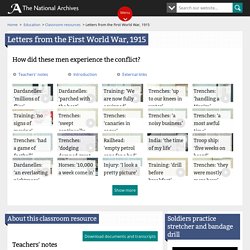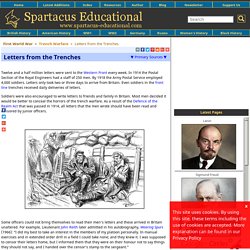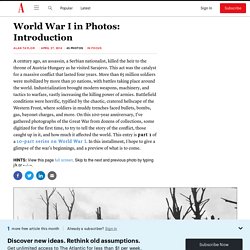

WWI A-Z - National WWI Museum and Memorial. National World War I Museum and Memorial. Letters from the first world war 1916 1918 3 trenches. Letters from the First World War, 1915. Download documents and transcripts Teachers' notes There are 32 letters and 16 photographs in this resource.

All letters have been transcribed, and selected letters have an audio version too. The documents should offer students a chance to develop their powers of evaluation and analysis. Teachers may also wish to use the collection to develop their own resources. You may spot spelling or grammatical errors in the transcripts as we have transcribed the letters as they stand. THE POETRY OF THE FIRST WORLD WAR. FIRST WORLD WAR POETRY Key war poets including Wilfred Owen and Siegfried Sassoon,famous war poems (with notes), war poetry anthologies, and maps War Poetry Books Minds at War Out in the Dark We Are the Dead French Poems of the First World War Also see our Books page for many more anthologies and collections of poems by individual poets.

About War Poets Rupert Brooke Wilfred OwenEdward Thomas Brief Lives of 25 War Poets What the War Poets Knew German Jewish poets of the First World War(Above include some portraits) War Poems (some with notes) Dulce et Decorum Est by Wilfred Owen Anthem for Doomed Youth by Wilfred OwenHere Dead We Lie by A E Housman Peace by Rupert BrookeThis is no case of . . . by Edward Thomas German Jewish war poems Pre-First World War poems that encouraged young men to fight: with an introduction to these poems.
Letters from the Trenches. We are now 150yd from Fritz and the moon is bright, so we bend and walk quietly onto the road running diagonally across the front into the Bosche line.

There is a stream the far side of this - boards have been put across it at intervals but must have fallen in - about 20yd down we can cross. We stop and listen - swish - and down we plop (for a flare lights everything up) it goes out with a hiss and over the board we trundle on hands and knees. Still. Apparently no one has seen so we proceed to crawl through a line of "French" wire. Now for 100yd dead flat weed-land with here and there a shell hole or old webbing equipment lying in little heaps! First World War centenary: Letters from the trenches reveal horror faced by our boys - BelfastTelegraph.co.uk.
Letters home from the Western Front in the First World War gave a snapshot of the horrendous conditions suffered by Ulster soldiers in the trenches.

On today's 100th anniversary of the declaration of war by Britain, we highlight some of the messages sent back to anxious friends and family. Name: Corporal Eric Bradshaw From: Ballymena Served with: Royal Engineers Written: from Rouen, France, to his father in 1915 About eight o'clock I reached a field ambulance and was brought to a clearing hospital further back. We stayed in that hospital for about two days and then were transferred to trains and brought here to Rouen.
You will have seen in the papers that our attack was a great success. Courtesy of www.ballymenaworld warone.com Name: Gordon Dill Long Smyth From: Belfast Written: 1916 to his mother in University Street My Dear Mother – Just a few lines to let you know that I am quite well. Courtesy of Fitzroy Presbyterian Church website Name: Ross Carton. Living in the Trenches. World War I in Photos: Introduction. A century ago, an assassin, a Serbian nationalist, killed the heir to the throne of Austria-Hungary as he visited Sarajevo.

This act was the catalyst for a massive conflict that lasted four years. More than 65 million soldiers were mobilized by more than 30 nations, with battles taking place around the world. Industrialization brought modern weapons, machinery, and tactics to warfare, vastly increasing the killing power of armies. Battlefield conditions were horrific, typified by the chaotic, cratered hellscape of the Western Front, where soldiers in muddy trenches faced bullets, bombs, gas, bayonet charges, and more. Facts & History. With Serbia already much aggrandized by the two Balkan Wars (1912–13, 1913), Serbian nationalists turned their attention back to the idea of “liberating” the South Slavs of Austria-Hungary. Colonel Dragutin Dimitrijević, head of Serbia’s military intelligence, was also, under the alias “Apis,” head of the secret society Union or Death, pledged to the pursuit of this pan-Serbian ambition.
Believing that the Serbs’ cause would be served by the death of the Austrian archduke Franz Ferdinand, heir presumptive to the Austrian emperor Franz Joseph, and learning that the Archduke was about to visit Bosnia on a tour of military inspection, Apis plotted his assassination. Nikola Pašić, the Serbian prime minister and an enemy of Apis, heard of the plot and warned the Austrian government of it, but his message was too cautiously worded to be understood.
Get a Britannica Premium subscription and gain access to exclusive content. Subscribe Now. America and World War One. America entered World War One on April 6th, 1917.

Up to that date, America had tried to keep out of World War One – though she had traded with nations involved in the war – but unrestricted submarine warfare, introduced by the Germans on January 9th, 1917, was the primary issue that caused Woodrow Wilson to ask Congress to declare war on Germany on April 2nd.